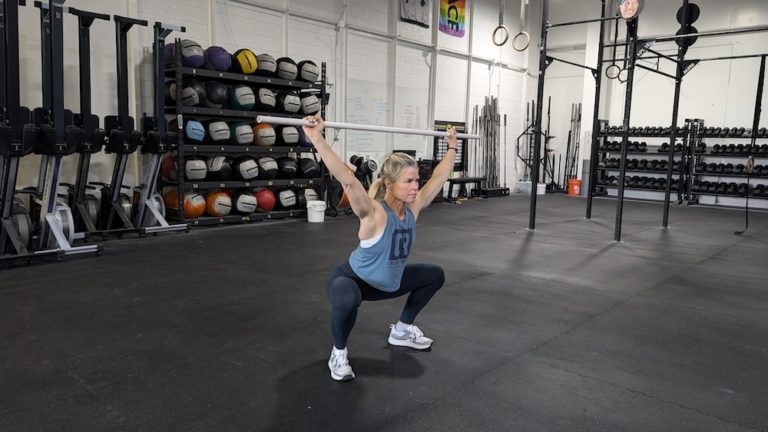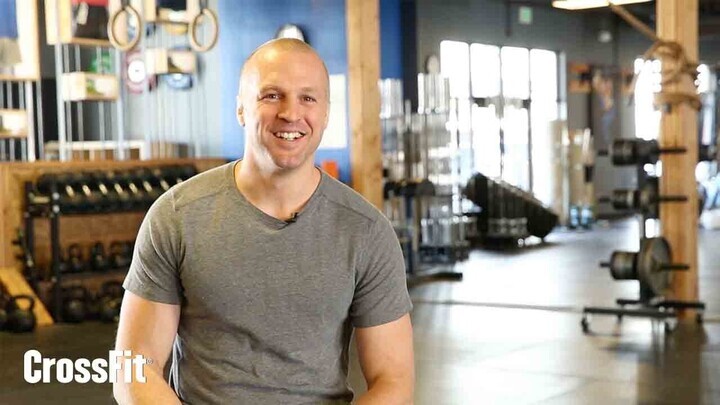Before my Level 1 Certificate Course in April 2007, I had never experimented with using the PVC pipe as a coaching and training tool. I always defaulted right to a barbell. I felt this way about any movement, whether a back squat or a full snatch. At my Level 1 Course, the PVC pipe was the tool of choice, yet I still missed the value of using the PVC myself.
Fast forward a year, and I attended a CrossFit Weightlifting Course Stephane Rochet and Josh Everett instructed. At this course, they drilled us HARD with a PVC pipe. They had us hold positions for what seemed like a thousand reps. After the course, my snatch improved by 30 lb! Before the course, I had been practicing the snatch frequently with a barbell, and my progress was far slower. I was amazed.
I drove home wondering, “How did I improve so much by using just a PVC pipe?” After some thought, I understood that the PVC pipe allowed me to:
- Feel the correct positions (specifically in the first pull).
- Hold static positions long enough to get frequent coaching.
- Perform significantly more reps than a barbell would have allowed.
I was bought in. Next, I had to learn the best time to utilize the PVC pipe to help athletes improve their movement and results. Here are four things I keep in mind when deciding to start with a barbell or PVC.
#1 – The Athlete’s Experience
When introducing an individual to the program for the first time, I typically use a PVC pipe regardless of the movement we are working on and their physical stature or previous experience with exercise. My rationale … why not? It allows me to assess the movement and progress from there. There is nothing wrong with starting “too light” or with “too little intensity.” But I can think of situations where I rushed to add weight too quickly, which often led to the mechanics of the movement being abysmal and sometimes causing pain or injury.
For athletes who are experienced with the program, you will likely be able to utilize a barbell for many of your movements throughout your specific warm-up and skill work. However, I still recommend you occasionally utilize a PVC pipe to allow for longer holds and pauses.
#2 – The Movement
There are certain movements I will use a PVC pipe for every time I teach it, and there are other movements where I may move to a barbell immediately. For example, I use a PVC pipe whenever I teach a snatch or an overhead squat. I came to this conclusion after jumping to a barbell too quickly and noticing people couldn’t hold the correct positions long enough because grip/trunk fatigue set in quickly. The PVC is too valuable for mechanical improvements and gaining an adequate warm-up to not use it for these movements. I have been doing CrossFit since 2006 and still warm up with a PVC pipe for these movements every time.
That said, I typically move directly to a barbell for movements like a back squat, front squat, or clean. For the clean, once you start to deliver the bar to the rack positions (e.g., muscle clean), the movement is very funky and challenging to perform with a PVC pipe, so I opt for a barbell. This means I must be mindful of the grip fatigue that may occur due to holding the barbell at the hang or starting position. If my focus for the teaching progression will be on the first pull of this lift, I may implement a barbell to increase the focus on reaching the appropriate positions while minimizing fatigue. Also, even if going to the barbell makes sense for 95% of the class, I will use the PVC pipe for new athletes who aren’t ready for it.
#3 – Kinesthetic Awareness
 One of the arguments against a PVC pipe is that it does not give you the feedback loading does to tell you you need to alter your mechanics. For example, when a barbell moves forward of the frontal plane in an overhead squat, you will feel that it’s moving forward and know you need to pull the bar back or you will miss the lift.
One of the arguments against a PVC pipe is that it does not give you the feedback loading does to tell you you need to alter your mechanics. For example, when a barbell moves forward of the frontal plane in an overhead squat, you will feel that it’s moving forward and know you need to pull the bar back or you will miss the lift.
This is exactly why the PVC pipe is so valuable. You should be able to perform the movement correctly, regardless of the load, and control your body and objects throughout space. Doing the movement unloaded builds kinesthetic awareness similar to the refinement of gymnastics movements.
#4 – Refining the Movement
Having your athletes use a PVC pipe gives you more chances to coach them and more opportunities for them to make adjustments. This is mainly due to being able to complete more reps with fatigue, which affects the quality of work to a lesser degree, and being able to hold athletes in static positions. This is valuable in any setting, particularly in a group environment where many reps are being completed.
Naturally, you’ll have to move to a barbell so your athletes have adequate build-up time, and you have a chance to assess them under load, but the PVC pipe is a brilliant tool to use in those initial minutes of class. Once athletes feel how it’s supposed to feel, they will be more tuned in to faults when moving weight.
If your default is to go directly to the barbell — like mine used to be — consider the four instances above and give the PVC some space to help your athletes get comfortable and improve their mechanics so they can achieve intensity more quickly.
 Eric O’Connor is a Content Developer and Seminar Staff Flowmaster for CrossFit’s Education Department and the co-creator of the former CrossFit Competitor’s Course. He has led over 400 seminars and has more than a decade of experience coaching at a CrossFit affiliate. He is a
Eric O’Connor is a Content Developer and Seminar Staff Flowmaster for CrossFit’s Education Department and the co-creator of the former CrossFit Competitor’s Course. He has led over 400 seminars and has more than a decade of experience coaching at a CrossFit affiliate. He is a